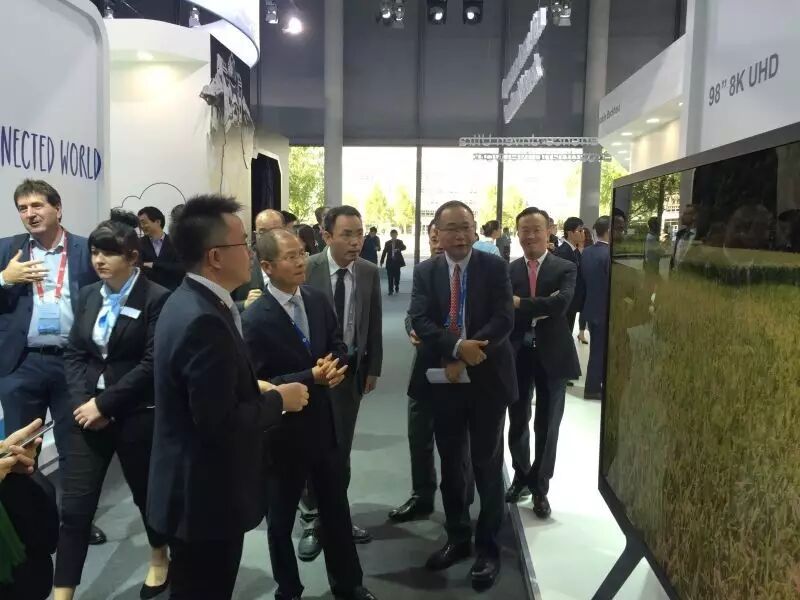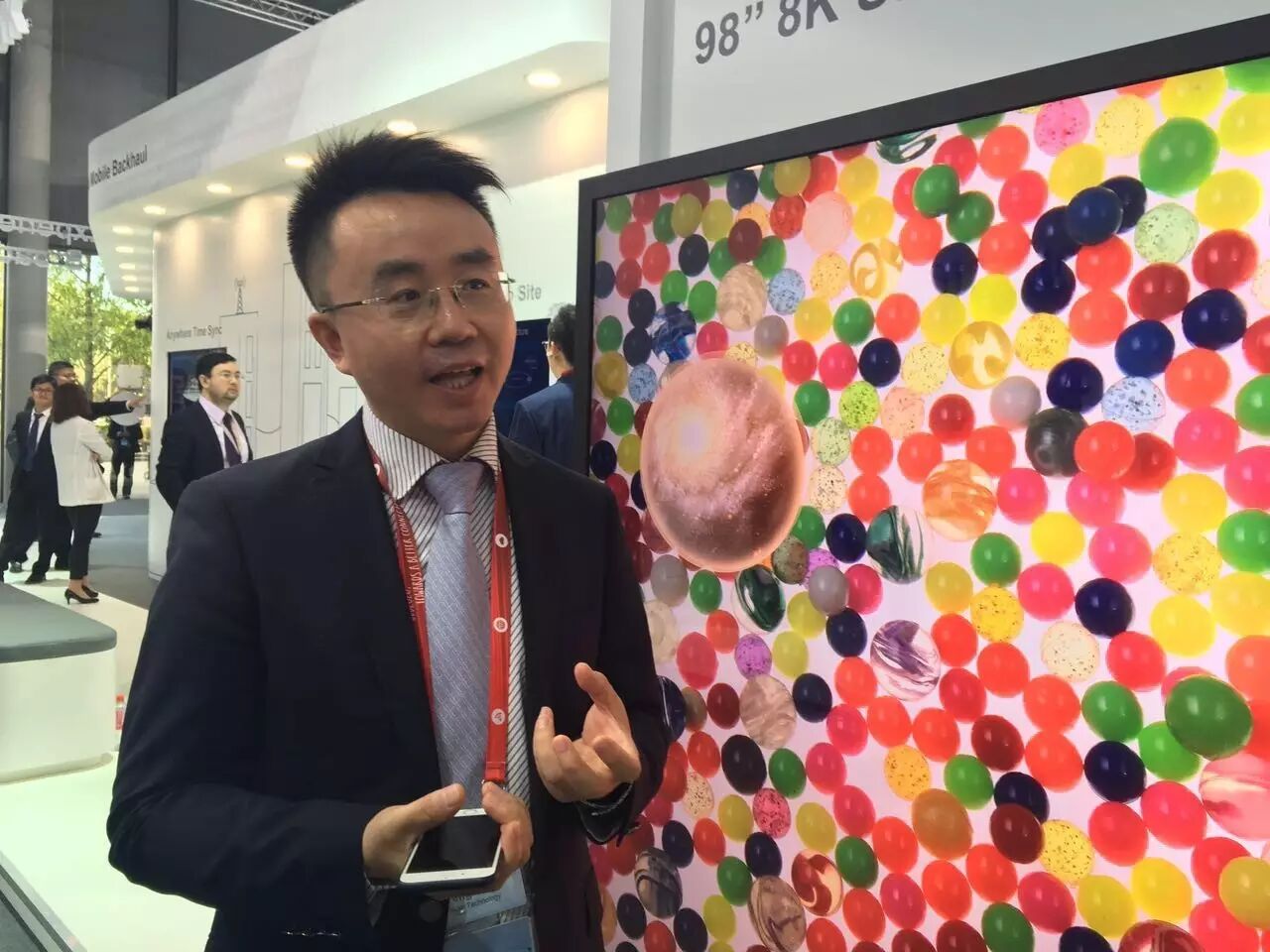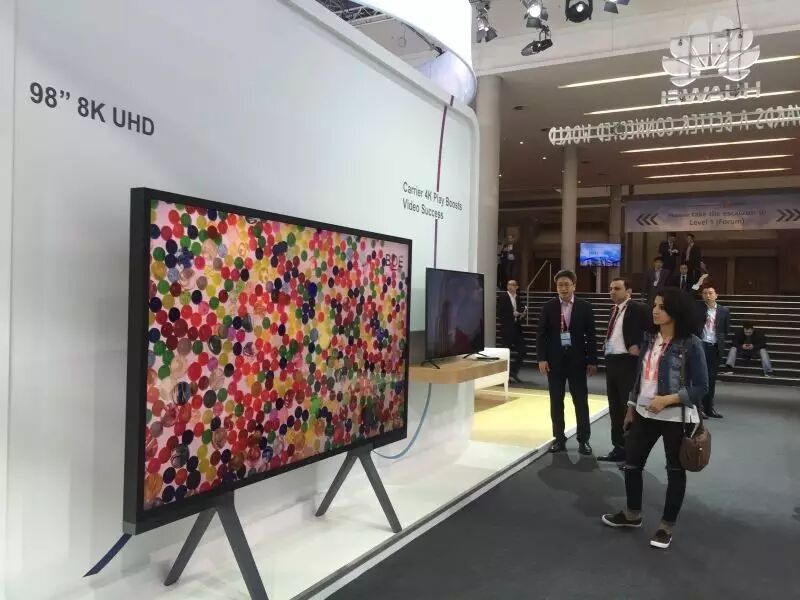What kind of era is the Internet of Things (IoT)? Certainly, the interconnection of all things is a necessary foundation, and from the perspective of ‘more interfaces’, the IoT era is more of a screen era.
The importance of large-screen televisions and mobile phone screens goes without saying. Even if a refrigerator actively sends out a ‘restock’ notification, it needs to be displayed on a mobile phone screen, or even on a small display screen on the refrigerator itself. Moreover, the automotive internet, which the entire industry is exploring today, also requires information to be presented in the car—whether on the in-car screen or using the front windshield as a display.
At the end of September, at the third Global Ultra-Wideband Forum (UBBF 2016) held in Frankfurt, Germany, BOE (Baidu Oriental) showcased the world’s first 98-inch 8K ultra-high-definition television, which offers an ultra-high-definition experience without any graininess, resembling real scenery. This not only amazed the attendees but also sparked some thoughts from the audience about the future ‘display’ era.
According to Yuan Feng, Vice President of BOE, the television based on BOE’s ultra-high-definition display was used for remote medical diagnosis for a foreign political figure. Thanks to the ultra-high-definition display, remote doctors could truly ‘see’ the various changes in organs, achieving accurate and efficient diagnoses.
In other words, in the IoT era, screen display has become an important carrier. So, in the face of this market opportunity, can Chinese companies at the forefront of display technology seize more opportunities? From this interview in Germany, it is clear that BOE is already prepared for such strategic expansion, aiming to transition from display technology to the ‘content, connection, interaction’ 3C value chain.
As the second-largest display manufacturer in the world after Samsung, can BOE leverage ‘display’ as a breakthrough to extend into smart systems and health services, and can it fully realize the value of ‘display’?
Furthermore, as ‘display’ becomes increasingly important, what new business models can be explored? This is where the true value for the industry lies, and we might as well analyze it.
Redefining: Semiconductor Display
To the general public, BOE may be an unfamiliar name, but for all companies related to screens, BOE is well-known.
In 2014 and 2015, BOE ranked first in the global market share for smartphone and tablet displays for two consecutive years. In the first half of 2016, BOE’s shipments of smartphone and tablet displays continued to grow steadily, maintaining the number one global market share; its monitor and television display market share ranked second globally, with television display shipments reaching 22.5 million units, a year-on-year increase of 47%, the highest growth rate globally.
Today, BOE is an important supplier for many world-renowned electronic brands, including Samsung, LG, Dell, HP, Lenovo, Huawei, Changhong, BestBuy, Hisense, Konka, Acer, Sony, ASUS, ZTE, Microsoft, MOTO, Xiaomi, OPPO, and vivo.
The achievements in the display field are closely related to the insights of BOE’s Chairman Wang Dongsheng into the industry. Through research on the technical characteristics of the semiconductor display industry and the cyclical fluctuations of the industry, he proposed the law of survival for enterprises: if prices remain unchanged, the performance of display products must improve by more than double every 36 months, and this cycle is being shortened.
Based on this law, BOE scientifically plans its product and technology innovation roadmap. Coupled with independent innovation, BOE’s technical capabilities now cover various display technologies, including amorphous silicon TFT-LCD, LTPS TFT-LCD, Oxide TFT-LCD, AMOLED, flexible displays, AR, VR, etc., and has made significant progress in enhancing performance in areas such as ultra-high-definition, high transmittance, low power consumption, ultra-narrow bezels, as well as in many application fields like multifunction integration, 3D display, touch, transparent display, and mirror display.
At the same time, BOE was the first in the global industry to propose a new definition of the semiconductor display industry, collectively referring to display devices with common semiconductor technology foundations, such as TFT-LCD, AMOLED, and flexible displays, as semiconductor displays. This definition has been recognized by global peers.

In fact, this understanding of the development direction of display technology has not only allowed BOE to continue to grow but has also greatly promoted the development of global display technology.
Since 2013, BOE has launched the world’s first 98-inch 8K, 110-inch 4K, 110-inch 8K, 82-inch 10K, 65-inch 8K, and 82-inch 10K curved ultra-large size ultra-high-definition display products, repeatedly winning important global awards. In September of this year, BOE’s globally launched thinnest 65-inch 8K ultra-high-definition display screen won the German ‘IFA Product Technology Innovation Award’ for the third time.
Additionally, during the 2016 Rio Olympics, BOE’s 98-inch 8K ultra-high-definition display screen achieved the world’s first 8K live broadcast at the Museum of Tomorrow in Brazil. The global highest generation line for producing large-size ultra-high-definition products—BOE’s Hefei 10.5 generation line—is expected to be put into production in 2018, which will further promote the rapid popularization of large-size ultra-high-definition display products.
The reason for listing so many achievements is to help readers further understand the global value of Chinese display technology. This value is also the foundation for Chinese enterprises to move towards the future and explore the forefront of industrial development.
Take the recent Global Ultra-Wideband Forum in Frankfurt, for example. Current operators are all considering how to deploy commercially valuable new businesses, among which 4K video is undoubtedly a blockbuster business driving ultra-wideband development, and the development of ultra-wideband networks has significant uplifting value for the global economy.
However, it is undeniable that with the gradual enrichment of 4K content and the acceleration of ultra-wideband network construction, the low penetration rate of 4K terminals has become a bottleneck restricting the development of the 4K video industry. At this time, BOE’s involvement with the power of ‘display’ not only explores a breakthrough path for the global ultra-wideband industry but also showcases the strength of Chinese enterprises.
At the event, many industry experts from Deutsche Telekom, BT, and Danish Telecom showed great interest in BOE’s display technology, which is naturally one of the reasons.
How to Seize Opportunities in the IoT?
If it were merely for commercial value, with BOE’s display technology, BOE could launch its own brand of televisions or smartphones and produce terminal products. However, BOE will not do this. BOE’s goal is not just to make money. As Wang Dongsheng stated in an interview with Fortune magazine: ‘China has a reasonable opportunity to become a leader on the world stage. Our technology can change the world.’
Using technology to change the world is BOE’s greater ideal and a more long-term profit strategy. Not pursuing immediate profits but achieving both ideals and commercial value is what makes a true industry transformer.
As Wang Dongsheng said, ‘We are in the post-internet era, moving towards the Internet of Things, and the foundation of the IoT is artificial intelligence and big data. Among them, display devices are essential core components.’ This statement actually reflects several opportunity dimensions in the future IoT era. One dimension is the foundational network, such as 5G, which is the direction that Huawei and Ericsson are planning; another dimension is artificial intelligence and big data, where many players, mainly internet companies, are competing; and another ‘interface’ dimension is screen display, where there are not many players from the display technology perspective, with Samsung, BOE, and Sharp being among them.
Wang Dongsheng proposed BOE’s future plan in 2014—a limited diversification strategy called ‘DSH’. ‘D’ stands for display devices, ‘S’ stands for smart systems, and ‘H’ stands for smart health services. This is BOE’s future direction: BOE’s products will focus on the display device business, with smart systems and smart health services as new transformation directions, ultimately achieving a service-oriented transformation through new industrial and technological advantages.
Focusing on display, exploring outward, and finding new value points in the future display era is the realization of BOE’s vision to change the world.

As Yuan Feng mentioned at the ultra-wideband forum, under the current maturity of ultra-high-definition display technology, the key to winning the market in the future lies in providing users with an unprecedented experience. BOE will provide a gradually realized ‘content, connection, interaction’ 3C (Content/ Connection/ Communication) value chain.
The more specific strategy is to leverage the experience and strength of ultra-high-definition display technology to build a new ecosystem for the ultra-high-definition industry in the IoT era together with content, consumer electronics, and the internet.
For example, BOE’s sensors and remote control technology, which have been successfully applied in production lines, can be used in fields like remote healthcare. Currently, BOE has established two international high-end comprehensive hospitals—Beijing Mingde Hospital and Hefei BOE Digital Hospital, which collaborates with Dignity Health in the US to introduce top international medical technology and operational concepts. Additionally, BOE plans to develop a health management and outcome-oriented big data analysis system in collaboration with IBM.
Of course, BOE’s ambitions are not limited to the healthcare sector; it hopes to deliver ‘smart value’. For instance, in smart manufacturing, BOE has a smart production line. I have visited BOE’s smart factory, which operates without any workers, and this smart factory is revolutionizing traditional manufacturing models, and BOE can export this capability.
In the field of smart automotive connectivity, BOE’s in-car display products have been applied to almost all mainstream automotive brands globally, providing high-definition, irregular, and curved in-car display modules, as well as full vehicle display systems, LCD antenna systems, driving assistance systems, and high-precision positioning systems, serving more automotive customers.
In the area of smart energy, BOE can provide intelligent detection and operation management platforms for real-time monitoring and management of power generation; it can also offer internet+ energy-saving lighting solutions for parking lots. As Yuan Feng mentioned, BOE’s office building has already become a huge future laboratory, featuring the largest solar roof in Beijing, a park that achieves wastewater self-treatment and recycling, and BOE has even built a plant factory utilizing photoelectric technology for soilless cultivation of fresh vegetables.
These are the future plans that BOE is currently devising.
It can be said that based on display technology, this is just a grasp for BOE to expand into the smart industry—an approach that aligns with the direction of IoT development. However, BOE is not limited to this; it aims to leverage the globally leading technologies that Chinese enterprises already possess to achieve greater commercial value while also changing the world.
Exploration: Innovative Transformation in the New Display Era
Smart manufacturing, smart healthcare, smart energy—these are the directions we already know. The layout in these areas shows BOE’s adaptability to the times, but if that were all, it would not be BOE.
The significance of an innovator lies in exploration, and this is also the focus of BOE and Wang Dongsheng’s thinking.
For example, many people hang a painting in their homes, perhaps a Van Gogh, but they cannot buy the original, so they hang a limited edition replica to satisfy their love. However, once they buy this painting, it is difficult to change it for a while. A Van Gogh lover might also like Monet or even contemporary avant-garde art, but can you change the painting in your living room every day?
High-definition display technology can bring real digital changes to our lives today. According to Yuan Feng, BOE is about to launch a smart product aimed at home and commercial use—iGallery. iGallery aims to digitize paintings and other artworks, integrating them with internet technology and cloud platforms, allowing users to appreciate global art treasures without leaving home.

In other words, today your living room can feature Van Gogh’s ‘Irises’, tomorrow it can be Monet’s ‘Impression, Sunrise’, and it can be a high-definition display of works that are nearly identical to the originals and copyright protected. The day after tomorrow, if you want to switch to your large photo, it can be done with just one click, even remotely.
This is the display value in the digital age, and it is the most realistic change in people’s lives based on display technology. With an overall solution of ‘hardware products + software platform + scenario applications’, this application not only brings new changes to consumers’ lives but also opens up new development possibilities for the art industry related to displays.
iGallery is just one of many explorations BOE is undertaking in the future. If this model succeeds, it can extend the innovative capabilities driven by ‘display’ to more fields.
Conclusion: Corporate Transformation—Sticking to Tradition or Changing the World?
‘Display’ is becoming a key force in the IoT era. BOE has clearly seized this window of opportunity and is prepared for transformation, extending from the display device business to smart systems and health services, accelerating the shift towards ‘soft and hard integration, application integration, and service-oriented transformation’, and building a new ecosystem for the network 3.0 era.
From an industry perspective, BOE’s 8K and 10K technologies have already placed Chinese enterprises at the forefront of global display technology. BOE’s display screens will undoubtedly be more valuable partners for many television and smartphone companies, and this is beyond doubt.
In the future IoT era, BOE’s plans for transformation are indeed keeping pace with the times, capturing the essence of the ‘screen connection’ era, leveraging the advantages of display technology, and beginning to explore new transformations like ‘display + art’.
To be honest, after understanding BOE’s transformation direction, I was somewhat surprised.
Because we all know that for a company like BOE, which possesses globally advanced technology, making money is not difficult. Continuing with the current 2B business model can be quite easy.
However, BOE is not that kind of company. Wang Dongsheng sees the ‘display’ opportunities in the future IoT era and is willing to explore and achieve things that his company previously could not focus on, such as iGallery.
Will iGallery definitely make BOE money? It is not clear at this point. But BOE has seen the new changes brought about by technological industrial transformation and is willing to undergo genetic changes for this, which is what I find most interesting.
Technology is constantly evolving. When a company, based on its technological accumulation, sees new changes and new business opportunities emerging in its field but remains unmoved, continuing down its old path, is that a good choice?
With great power comes great responsibility; this is not an exaggeration. In the field of display technology, BOE, which has the capability, is merely combining its accumulation to adapt to the industrial transformation, exploring with flexibility, and doing its best to change the industry. This is the direction a company should take during technological transformation, and I endorse this.
=================
Readers can check for updates on Li Yinghuan’s articles on major platforms such as Baidu Baijia, Tencent News, Toutiao, Sohu News, NetEase News, Sina Blog, UC self-media platform, and Sina Weibo.
Li Yinghuan (ID: yinghuanlee) is a member of the Wemedia Alliance, covering over 10 million people, and was awarded the top ten self-media in 2013, the most influential self-media in 2014 and 2015, and one of the top ten technology observers on Weibo in 2015.
For reprints and collaborations, please contact WeChat:wkd772856958